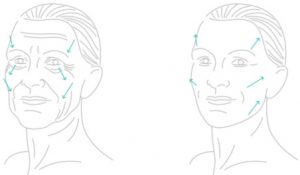 Facelift or rhytidectomy is the name given to surgery that corrects sagging of the face. Over time, continued action of gravity pulling the tissue down and genetics, sagging of the skin and musculature of the face occurs; which causes an aged and tired appearance.
Facelift or rhytidectomy is the name given to surgery that corrects sagging of the face. Over time, continued action of gravity pulling the tissue down and genetics, sagging of the skin and musculature of the face occurs; which causes an aged and tired appearance.
 1. How many years can I expect to rejuvenate with a facelift?
1. How many years can I expect to rejuvenate with a facelift?
It is expected that the surgery will make the patient’ face rejuvenate. But the amount of years is something very relative. I would rather say that with surgery, the patient will present a softer, harmonious and rested look, giving the impression that the face is younger.
2. How long do the effects of the surgery last?
Unfortunately, surgery cannot stop time. Despite surgery, the influence of severity and physiological aging over the body will continue. The patient continues to age naturally, but it will always be much better than if you had not done the surgery because the tissue will have been repositioned and the excess removed.
3. What type of anesthesia is used for facelifts?
In most cases, we choose local anesthesia and sedation. Medication is provided so that the patient can sleep calmly. Subsequently, we perform local anesthesia so that there is no pain. In some cases, general anesthesia may be needed.
4. What are the scars?
It depends on the treatment each patient needs. The rhytidectomy surgery options are the traditional lift, lift with limited incision or neck Iift. A traditional lifting incision, often begins in front of the ears extending behind them and ending in the scalp. Because it is the region of the face, the scars usually become unnoticeable after the first few months.
5. When will the stitches be removed?
For this type of surgery we use absorbable sutures, that is, wires that are degraded by the body itself. Thus, the stitches do not need to be removed, they will disappear by themselves.
6. Is the surgery very painful?
Usually there is no pain. When the patient wakes up from sedation, anesthesia will still be working on the point of surgery. We prescribe simple analgesics that patients can take at home, prophylactically, that is, before they can feel pain.
7. Does the incision get very swollen and purple?
In the first 2 to 5 days, edema (swelling) and ecchymosis (purple) may be present. But, this will depend on how each patient responds to surgery.
8. How long does the surgery last?
Usually from 3 to 4 hours.
9. How long will I need to stay in hospital?
From 10 to 24 hours.
 10. With the facelift, will wrinkles disappear?
10. With the facelift, will wrinkles disappear?
The facelift aims to reposition the tissues and the remove those excesses. Wrinkles are caused by mimic and facial expression, and will require additional treatments such as botulinum toxin, fillers and / or facial peels to improve the quality of skin that has been repositioned.
11. Can I have eye surgery simultaneously?
Yes, blepharoplasty (surgery for eye rejuvenation) is a surgery most commonly associated with the facelift.
12. Is lymphatic massage necessary?
The massages are very important. The first massage is performed about 4 days after surgery. We recommend 10 drainage sessions to be performed every 2 or 3 days. In addition to reducing the swelling of the face, drainages also help in remodeling scars.
13. Will I get be able wash and comb my hair?
Yes, from the 2nd post-operative day, that will be authorized.

